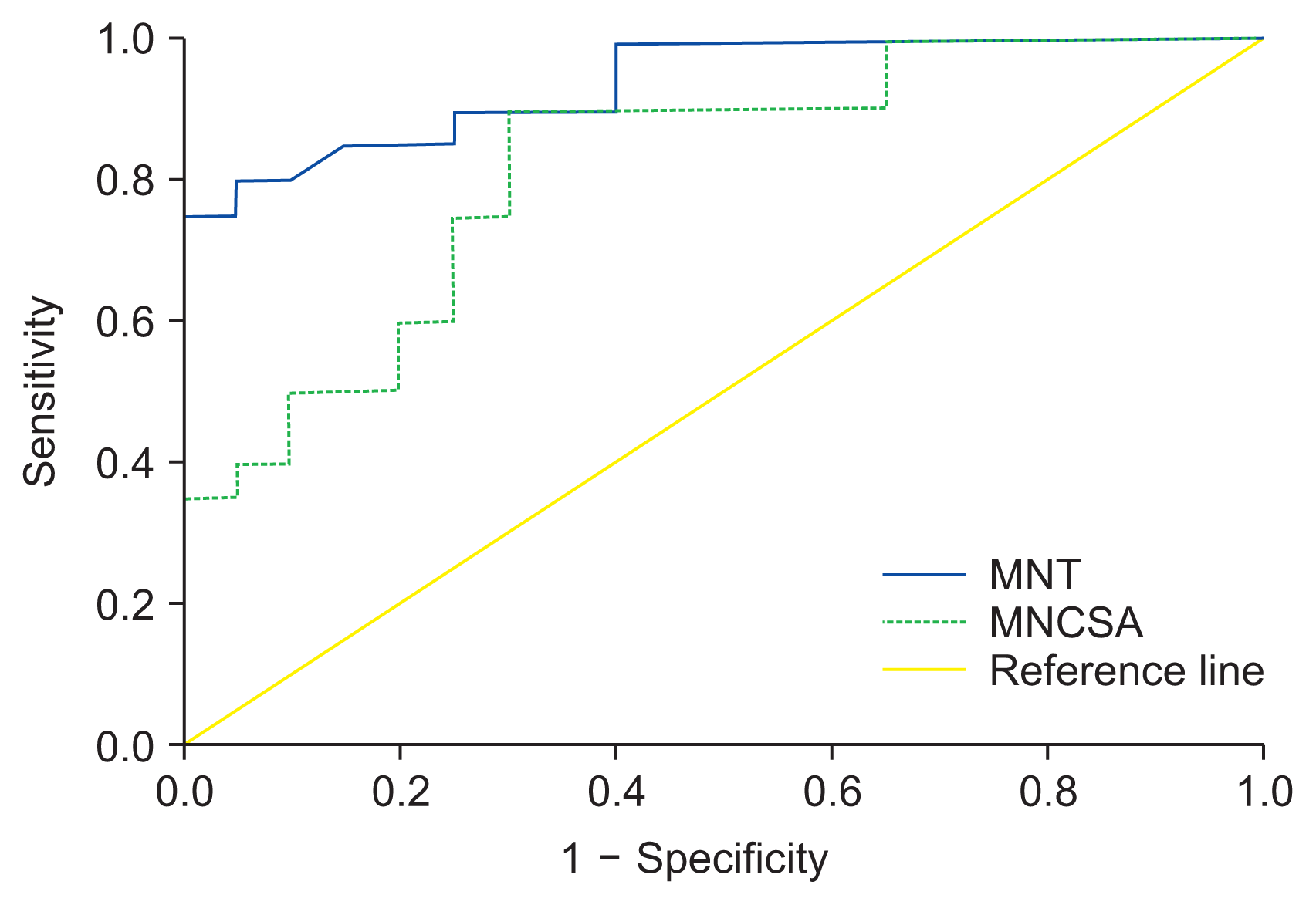1. Chammas M, Boretto J, Burmann LM, Ramos RM, Dos Santos Neto FC, Silva JB. Carpal tunnel syndrome - part I (anatomy, physiology, etiology and diagnosis). Rev Bras Ortop. 2014; 49:429–36. DOI:
10.1016/j.rbo.2013.08.007. PMID:
26229841. PMCID:
4487499.

2. Aroori S, Spence RA. Carpal tunnel syndrome. Ulster Med J. 2008; 77:6–17. PMID:
18269111. PMCID:
2397020.
4. Ikeda M, Okada M, Toyama M, Uemura T, Takamatsu K, Nakamura H. Comparison of median nerve cross-sectional area on 3-T MRI in patients with carpal tunnel syndrome. Orthopedics. 2017; 40:e77–81. DOI:
10.3928/01477447-20160915-04. PMID:
27648575.

5. Jarvik JG, Yuen E, Kliot M. Diagnosis of carpal tunnel syndrome: electrodiagnostic and MR imaging evaluation. Neuroimaging Clin N Am. 2004; 14:93–102. viiiDOI:
10.1016/j.nic.2004.02.002. PMID:
15177259.

6. Kleindienst A, Hamm B, Lanksch WR. Carpal tunnel syndrome: staging of median nerve compression by MR imaging. J Magn Reson Imaging. 1998; 8:1119–25. DOI:
10.1002/jmri.1880080518. PMID:
9786151.

7. El-Karabaty H, Hetzel A, Galla TJ, Horch RE, Lücking CH, Glocker FX. The effect of carpal tunnel release on median nerve flattening and nerve conduction. Electromyogr Clin Neurophysiol. 2005; 45:223–7. PMID:
16083145.
8. Atan T, Günendi Z. Diagnostic utility of the sonographic median to ulnar nerve cross-sectional area ratio in carpal tunnel syndrome. Turk J Med Sci. 2018; 48:110–6. DOI:
10.3906/sag-1707-124. PMID:
29479967.

9. Crasto JA, Scott ME, Fowler JR. Ultrasound measurement of the cross-sectional area of the median nerve: the effect of teaching on measurement accuracy. Hand (N Y). 2019; 14:155–62. DOI:
10.1177/1558944717731857. PMID:
28929789. PMCID:
6436120.

10. Duetzmann S, Tas S, Seifert V, Marquardt G, Dombert T, Staub F. Cross-sectional area of the median nerve before revision carpal tunnel release-a cross-sectional study. Oper Neurosurg (Hagerstown). 2018; 14:20–5. DOI:
10.1093/ons/opx079. PMID:
29253286.

11. Ghasemi M, Masoumi S, Ansari B, Fereidan-Esfahani M, Mousavi SM. Determination of cut-off point of cross-sectional area of median nerve at the wrist for diagnosing carpal tunnel syndrome. Iran J Neurol. 2017; 16:164–7. PMID:
29736220. PMCID:
5937000.
12. Hersh B, D’Auria J, Scott M, Fowler JR. A Comparison of ultrasound and MRI measurements of the cross-sectional area of the median nerve at the wrist. Hand (N Y). 2019; 14:746–50. DOI:
10.1177/1558944718777833. PMID:
29799270. PMCID:
6900683.

13. Atroshi I, Gummesson C, Johnsson R, Ornstein E, Ranstam J, Rosén I. Prevalence of carpal tunnel syndrome in a general population. JAMA. 1999; 282:153–8. DOI:
10.1001/jama.282.2.153. PMID:
10411196.

14. Ferry S, Pritchard T, Keenan J, Croft P, Silman AJ. Estimating the prevalence of delayed median nerve conduction in the general population. Br J Rheumatol. 1998; 37:630–5. DOI:
10.1093/rheumatology/37.6.630. PMID:
9667616.

15. Kim JK, Koh YD, Kim JO, Choi SW. Changes in clinical symptoms, functions, and the median nerve cross-sectional area at the carpal tunnel inlet after open carpal tunnel release. Clin Orthop Surg. 2016; 8:298–302. DOI:
10.4055/cios.2016.8.3.298. PMID:
27583113. PMCID:
4987314.

16. Klauser AS, Halpern EJ, De Zordo T, Feuchtner GM, Arora R, Gruber J, et al. Carpal tunnel syndrome assessment with US: value of additional cross-sectional area measurements of the median nerve in patients versus healthy volunteers. Radiology. 2009; 250:171–7. DOI:
10.1148/radiol.2501080397. PMID:
19037017.

17. McDiarmid M, Oliver M, Ruser J, Gucer P. Male and female rate differences in carpal tunnel syndrome injuries: personal attributes or job tasks? Environ Res. 2000; 83:23–32. DOI:
10.1006/enrs.2000.4042. PMID:
10845778.

18. Bodofsky EB, Campellone JV, Wu KD, Greenberg WM. Age and the severity of carpal tunnel syndrome. Electromyogr Clin Neurophysiol. 2004; 44:195–9. PMID:
15224813.
19. Deryani E, Aki S, Muslumanoglu L, Rozanes I. MR imaging and electrophysiological evaluation in carpal tunnel syndrome. Yonsei Med J. 2003; 44:27–32. DOI:
10.3349/ymj.2003.44.1.27. PMID:
12619172.

20. de Campos CC, Manzano GM, Leopoldino JF, Nóbrega JA, Sañudo A, de Araujo Peres C, et al. The relationship between symptoms and electrophysiological detected compression of the median nerve at the wrist. Acta Neurol Scand. 2004; 110:398–402. DOI:
10.1111/j.1600-0404.2004.00332.x. PMID:
15527453.

21. Wu HT, Schweitzer ME, Culp RW. Potential MR signs of recurrent carpal tunnel syndrome: initial experience. J Comput Assist Tomogr. 2004; 28:860–4. DOI:
10.1097/00004728-200411000-00024. PMID:
15538166.

22. Brahme SK, Hodler J, Braun RM, Sebrechts C, Jackson W, Resnick D. Dynamic MR imaging of carpal tunnel syndrome. Skeletal Radiol. 1997; 26:482–7. DOI:
10.1007/s002560050270. PMID:
9297753.

23. Keberle M, Jenett M, Kenn W, Reiners K, Peter M, Haerten R, et al. Technical advances in ultrasound and MR imaging of carpal tunnel syndrome. Eur Radiol. 2000; 10:1043–50. DOI:
10.1007/s003300000386. PMID:
11003395.

24. Musluoğlu L, Celik M, Tabak H, Forta H. Clinical, electrophysiological and magnetic resonance imaging findings in carpal tunnel syndrome. Electromyogr Clin Neurophysiol. 2004; 44:161–5. PMID:
15125056.
25. Bagga B, Sinha A, Khandelwal N, Modi M, Ahuja CK, Sharma R. Comparison of magnetic resonance imaging and ultrasonography in diagnosing and grading carpal tunnel syndrome: a prospective study. Curr Probl Diagn Radiol. 2019; DOI:
10.1067/j.cpradiol.2019.04.004. PMID:
31126663.

26. Holováčová D, Kužma M, Killinger Z, Payer J. Cross-sectional area of the median nerve is increased in primary autoimmune hypothyroidism and decreases upon treatment with thyroxine. Eur J Endocrinol. 2016; 175:265–71. DOI:
10.1530/EJE-16-0397. PMID:
27418060.

27. Pulikkottil BJ, Schub M, Kadow TR, Wang W, Fowler JR. Correlating median nerve cross-sectional area with nerve conduction studies. J Hand Surg Am. 2016; 41:958–62. DOI:
10.1016/j.jhsa.2016.08.018. PMID:
27702467.

28. Devers BN, Douglas KC, Naik RD, Lee DH, Watson JT, Weikert DR. Outcomes of hook of hamate fracture excision in high-level amateur athletes. J Hand Surg Am. 2013; 38:72–6. DOI:
10.1016/j.jhsa.2012.10.011. PMID:
23200952.

29. Chow JC, Weiss MA, Gu Y. Anatomic variations of the hook of hamate and the relationship to carpal tunnel syndrome. J Hand Surg Am. 2005; 30:1242–7. DOI:
10.1016/j.jhsa.2005.05.018. PMID:
16344183.

30. Hohenberger GM, Maier MJ, Grechenig C, Schwarz AM, Matzi V, Weiglein AH. Carpal tunnel release: safe and simple identification of the flexor retinaculum based on superficial anatomical landmarks. Clin Anat. 2017; 30:512–6. DOI:
10.1002/ca.22865. PMID:
28247938.

31. Ratnaparkhi R, Xiu K, Guo X, Li ZM. Changes in carpal tunnel compliance with incremental flexor retinaculum release. J Orthop Surg Res. 2016; 11:43. DOI:
10.1186/s13018-016-0380-3. PMID:
27074707. PMCID:
4831089.






 PDF
PDF Citation
Citation Print
Print



 XML Download
XML Download